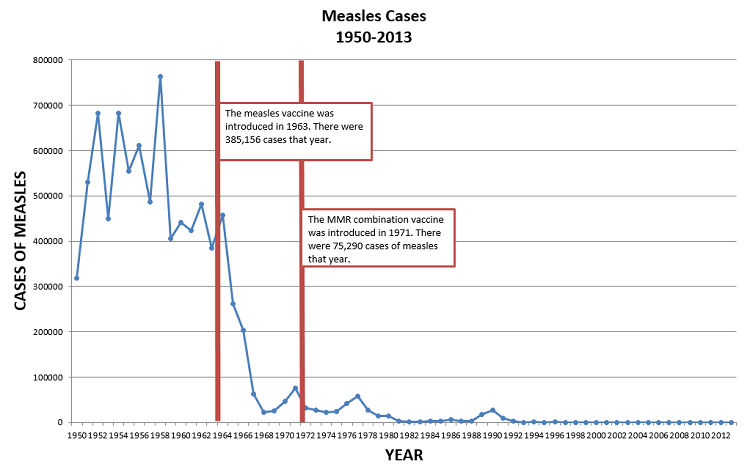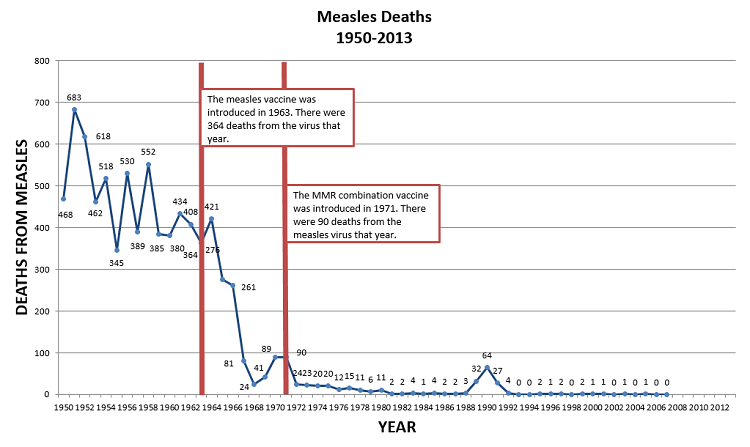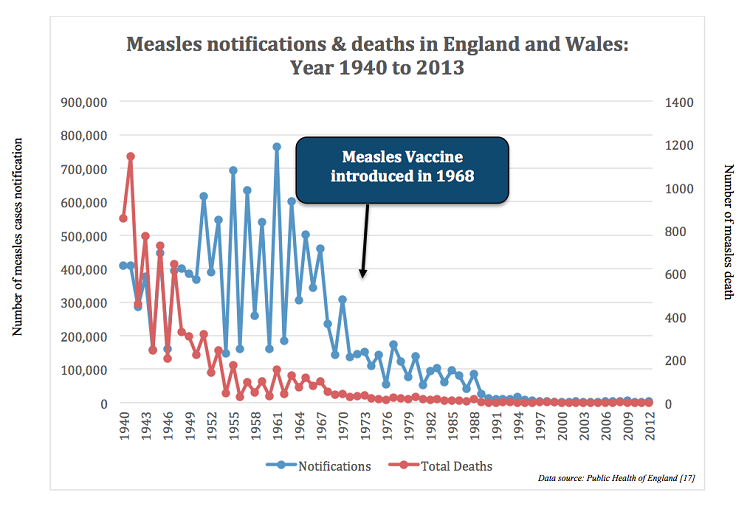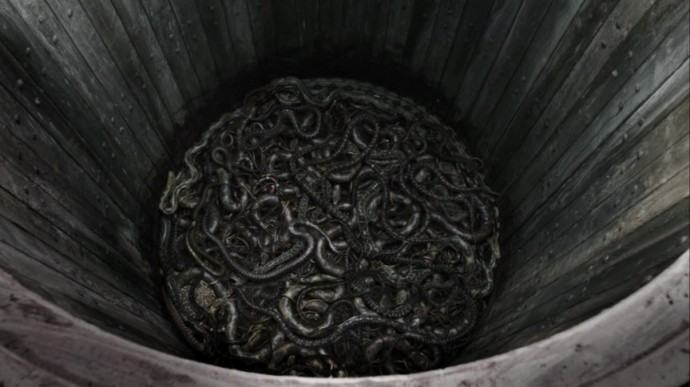An article in Time magazine, dated June 24, 2019, was published under the heading of “Vaccine Wars”. As most people are aware, this article was predicated on the appearance of a measles epidemic. It has given rise to a national panic concerning the dangers of vaccination versus the problems associated with measles. Is the panic justified? More importantly, is the response, which is to mandate vaccination, justified? I turned to the history of measles before the 1963 introduction of the vaccine, using online information available to all. Prior to 1912, measles was not a reportable disease in the United States. In 1920 there were 469,924 recorded cases of measles and 7,575 deaths associated with it. From 1958 to 1962, the U.S. Averaged 503,282 cases and 432 deaths each year. In 1963 the CDC admitted that there was massive under-reporting of measles cases “because virtually all children acquired measles, the number of cases probably approached 3.5 million, an entire birth cohort”. In 1969, measles deaths were estimated at one in 10,000.
When I was growing up in England, measles, chickenpox, mumps and rubella (German measles) were regarded as the “childhood diseases”. They were not regarded as dangerous and were accepted as “rites of passage” in development. In spite of a relatively rare complication, all of them, including measles, were believed to stimulate an active immune system in a healthy child, to last a lifetime. For a number of years I was in family practice in England, before the introduction of the measles vaccine in 1963, an epidemic of the disease would simply be expected every two years. In my practice, I would see as many as 200 cases with each epidemic, but I never saw any complication, let alone a death. It may well be that getting rid of these diseases by means of vaccination is yet another example of the general movement of humanity away from our biologic origins. But Mother Nature (MN) is also a hard task master. By making sure that all the nutritional elements for maintaining health are naturally available and assuming that the genetic “blueprint” is intact, MN has provided a method by which a healthy child can grow up to face the many challenges to his/her immune system as an adult.
Notice the graphs below, showing the decline in mortality of measles over a period of 63 years, probably reflecting an overall improvement in nutrition and lifestyle. It seems that the conclusions are inevitable: that poor overall health in the child creates a susceptibility to complications, whether attacked naturally by the measles virus or artificially by the vaccination. Vaccination imposes additional risks because of the added adjuvants and the propensity to administer multiple vaccinations together and in series. A vaccination may act as a nonspecific stressor and it may be that it should only be given to a child whose health is defined in natural terms. If there are other factors that decrease the overall health of the child, the vaccine may simply act as the “last straw”, leading to further breakdown in health.
Figure 1. Measles Cases in the US.

Figure 2. Measles Deaths in the US.

Figure 3. Measles Cases and Deaths in England and Wales.

Postural Orthostatic Tachycardia Syndrome – POTS
Although recorded on Hormones Matter previously, I want to draw your attention once more to information in my paper that was published in 2015, because I believe that it addresses the problem of vaccination in general. A vaccine given to children and young adults who are already compromised in overall health, may precipitate serious disease.
Here is the evidence. An 18-year-old girl came to my attention because she had developed a form of dysautonomia known as POTS (postural orthostatic tachycardia syndrome), immediately following vaccination with Gardasil vaccine (the vaccine used to prevent cancer of the cervix). Regarded by all who knew her as a healthy athlete and superior student before vaccination, she had been crippled for four years with many medical consultations, lacking any benefit. The mother had done her own research and came to the conclusion, unlikely as it sounds, that her daughter had beriberi, the vitamin B1 deficiency disease. A blood test proved her to be correct. As a result of this, two other girls and a boy, all suffering from post-Gardasil POTS, were brought to my attention. All were proved to be deficient in thiamine (vitamin B1). Further inquiry into the case of the vaccinated boy revealed that his father had Wernicke encephalopathy (a brain disease usually acquired from excessive alcohol consumption) and there was a strong family history of alcoholism, suggesting that there was genetically determined thiamine associated risk. Another girl who was suffering from POTS was also brought to my attention although she had not received the vaccine. She was also proved to be thiamine deficient. A neurologist published a paper in 2017 reporting a number of patients with POTS who were thiamine deficient. Another important factor to be considered is that each of these affected young people were regarded as brilliant athletes and academic students before their vaccination.
Putting it All Together
I cannot prove what I am about to say, but the evidence quoted above strongly suggests that there is a perfectly rational explanation for something that would be regarded by most people as absurd. They would be likely to conclude that thiamine deficiency was the sole cause and that the vaccination was coincidental and blameless, ignoring her pristine health before receiving the vaccine. It is true, of course, that thiamine has to be absorbed from food and its deficiency is essentially dietary in origin. It is consumed in the body and requires continuous replacement throughout life. This was shown by the girl above who was thiamine deficient but had not received vaccination. The most likely possibility for an association with vaccination is that each of the affected students was marginally deficient in thiamine from poor diet but that the deficiency was not bad enough to cause symptoms before vaccination. It is also possible that minor symptoms (e.g.an allergy) were actually those of marginal deficiency that had been ignored or treated symptomatically. Injection of the vaccine, acting as a stressor, simply precipitated an increased energy demand that caused an increase in thiamine consumption that was already in short supply. The report of their academic and athletic ability suggested that they possessed superior brain function that consumed energy faster than those less well endowed. Thus, it is hypothesized that the vaccination precipitated a greater degree of deficiency that either initiated the symptoms of POTS or accelerated existing minor symptoms. It is important to emphasize that these young people had been virtually crippled for several years without any recognition of the true nature of their disease. The three circles of health, genetic risk, stress and nutrition were each involved in the outcome. Draining the available energy in meeting the stress resulted in biochemical changes in the lower brain and autonomic network, resulting in the clinical expression of POTS.
The Triad of Risk
This suggests that the triad of genetic risk, stress, and nutrition work in a variable association and that the vaccination is not dangerous in itself, but simply acts as an agent that stresses the biochemical and electric integrity of the vaccinated individual to adapt. Others may disagree with this explanation considering the current recipe of adjuvants used in the preparation of the vaccine. But this is a fair statement considering the common state of nutrition that exists throughout America and particularly in adolescents. We are also gradually becoming aware that this common form of high calorie malnutrition in pregnancy can be as bad as starvation for the long-term health of the fetus and that it has a prolonged effect on the child’s development after birth. The health of the offspring is precarious at best and the risk of the vaccine stressor becomes immense. It has recently been shown that autism is linked to malnutrition in pregnancy.
I remember a young boy who had contracted chickenpox, an otherwise trivial infection. His general appearance and home base suggested that he was far more ill than would be accepted solely from the chickenpox and he subsequently died in hospital. In other words, it was not the chicken pox per se that caused his death, but his inability to adapt to the infection because he did not have sufficient reserves to fight it. It was the lack of nutrient reserves to fuel the appropriate immune response. In such circumstances, he could have just as easily died from the infection or from a vaccination. The ultimate conclusion is that vaccination is a safe choice only if the child receiving it is in a state of nutritional well-being or is unaffected by genetic risk affecting energy metabolism. The overall health of the child should be assessed appropriately before receiving a vaccination. What appear to be trivial symptoms, even those affecting intractable behavior, and often considered to be psychological in origin, are caused by subtle changes in the electrochemistry of the brain. Although this is commonly due to nutritional mayhem, it can also be caused by a background of genetic risk that affects energy metabolism, particularly in the brain. It would seem to be mandatory for a physician to know the overall health of the family from which the child comes, providing an assessment of vaccination risk. This may be impossible, but vaccination should always be taken seriously in assessing risk. Above all, it should be a parental choice.
We Need Your Help
More people than ever are reading Hormones Matter, a testament to the need for independent voices in health and medicine. We are not funded and accept limited advertising. Unlike many health sites, we don’t force you to purchase a subscription. We believe health information should be open to all. If you read Hormones Matter, like it, please help support it. Contribute now.













the Gardisil is very high in Aluminum, this probably disturbs gut bacteria and/or increases fungal overgrowth which affects thiamine uptake…a similar situation to the MMR which is also high in Aluminum
there is no safe level of Aluminum in the body, vaccines need to be banned
This is a reply to Andrea and Sharon. First, please understand that taking non-caloric supplements is new and is relatively cheap. Do you think that the pharmaceutical industry wants it to succeed? All sorts of “dangers” associated with their use are published to try to beat them down. Their success is predicated on biochemistry and few physicians have maintained the knowledge that they obtained in med school. The recommended concentrations of these essential dietary components was virtually guess work by supposed experts. I agree with Andrea that natural food does not have the nutrient density that it used to have when farmers used manure to recycle them. Since vitamin enrichment is presumably based on the RDAs, the necessary concentrations are not reached, particularly for high metabolic rate brains (high IQ). A large segment of our society is vitamin/ mineral deprived. They may have no symptoms of their deficiency because a symptomatic threshold has not been reached, but some form of stress (injury, infection,surgery, a prolonged divorce etc) can precipitate a full blown deficiency where the illness is attributed solely to the stress without considering an associated energy dependent mechanism. Or they might have symptoms (e.g an allergy) attributed to other causes better accepted (but wrong nevertheless). A common mistake is to call the polysymptomatic illness of early deficiency “psychosomatic”, thus allowing things to get worse and perhaps become irreversible. Sharon mentions the gut biome that is a focus of attention. However, bacteria require vitamins also to do their important function and the explanation of their delinquency may well fall into the same diagnostic blindness that pervades our present medical system. This answer is built on decades of clinical experience and I am happy to state that articles are at last appearing in the medical literature in support. However, few of them originate in American institutions because of the massive overall view that vitamin deficiency disease has been conquered and anyone stating that this is simply not true is considered to be at least an incongruity.
I’ve struggled for several years with the notion of whether supplements are really necessary when one follows a balanced ‘diet‘ (and of course what I mean here is simply eating Mother Nature’s food – not some fad diet). Given the current state of our agriculture however, I’ve also become more and more convinced that even natural foods simply cannot anymore supply sufficient nutrients, and have turned to daily supplementation – B-complex, magnesium, selenium, and zinc. And since discovering your work, 50 mg allithiamine daily as well.
However, I’m also concerned with some of the data out there suggesting that regular supplementation (in absence of disease) could possible act as a trigger for cell transformation or supporting malignant cell growth, down the line. What are your thoughts on this? is there a risk in daily supplementation in the absence of a known deficiency?
From what i have read in the GUT group, there is a flora shift in the biome, and the production of nutrients by various microbes is disturbed, leading to adverse events from vaccination…for some and not others… Wherever the chick and the egg, the cause and effect might rest…more likely akin to three dimensional chess..when many feed back loops, and perfect storms for each individual. Acute adverse outcomes may just be one way…another is long term chronic disease outcomes.